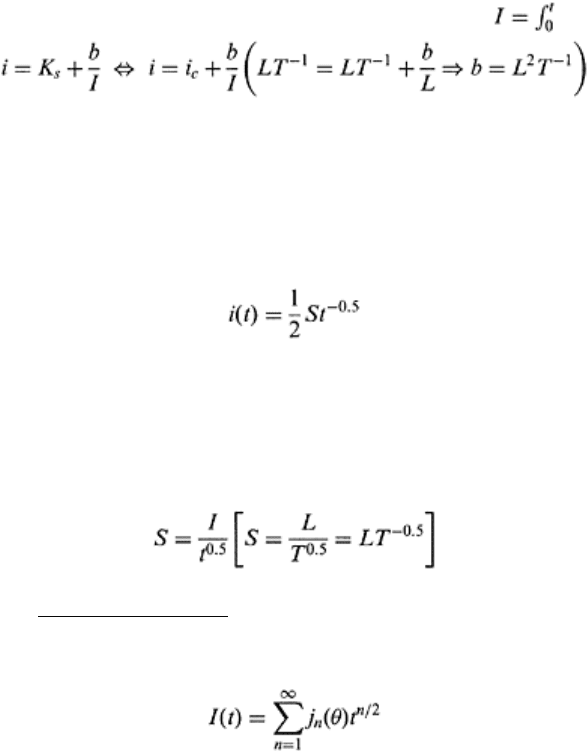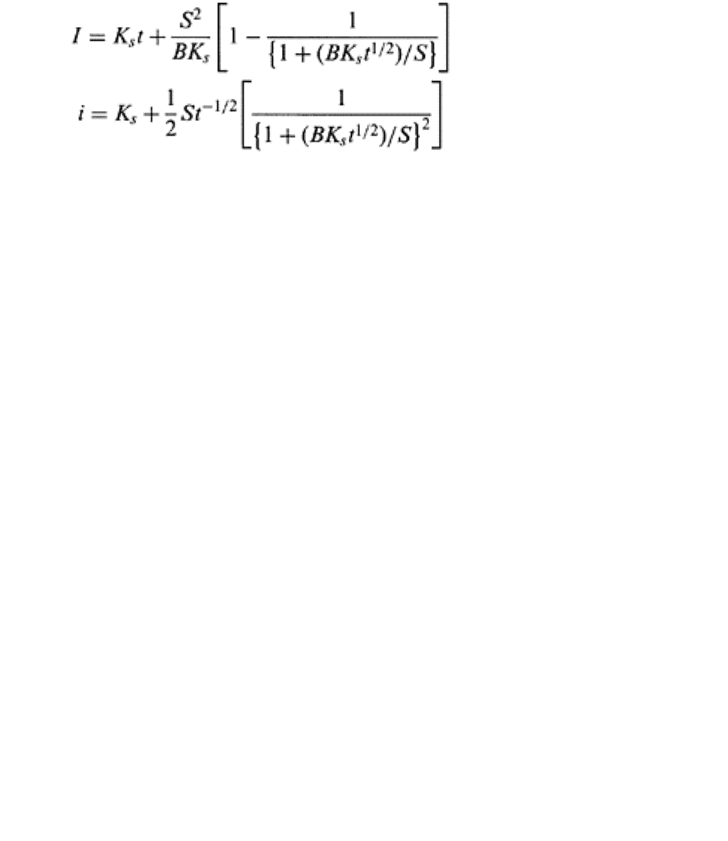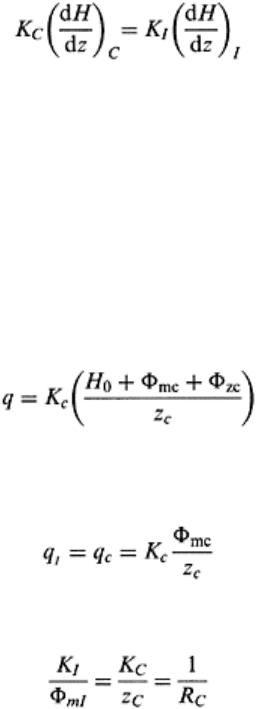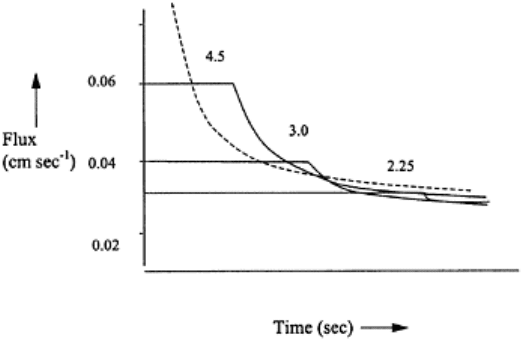Lal R., Shukla M.K. Principles of Soil Physics
Подождите немного. Документ загружается.


FIGURE 14.7 Infiltration through (a)
a natural homogeneous soil (b) Green–
Ampt approximation.
where K
s
is the saturated hydraulic conductivity (LT
−1
) of wetted region 0<x<L, ∆H is the
hydraulic head difference between wetting front (W
f
) and soil surface (W
0
). Figure 14.7
explains the natural soil water profile wetting and the corresponding Green–Ampt profile.
The infiltration will increase the moisture content of the soil profile. Assuming a
uniformly wetted zone up to the wetting front with cumulative infiltration (I) equal to the
product of wetting front depth (L) and increase in moisture content (∆θ). Similarly,
infiltration rate equals the rate of change in water storage per unit time:
(14.3)
where I is the total or cumulative infiltration within a selected time interval, θ
s
and θ
i
are
the saturated moisture content and initial moisture content, respectively (∆θ=θ
s
−θ
i
).
Equating the right-hand side of Eqs. (14.2) and (14.3):
(14.4)
After rearranging the equation so that factors dependent on L and time are on one side,
Eq. (14.4) can be integrated to the limits of 0 to L and 0 to t as follows
(14.5)
Eq. (14.6) is obtained after integrating Eq. (14.5) and from Eq. (13.24)
(14.6)
Principles of soil physics 384

where D(θ)
0
is soil-water diffusivity of the wet soil region
(14.7)
The cumulative infiltration (I=L∆θ) can be obtained from Eq. (4.6) after multiplying the
second term with ∆θ/Dθ and rearranging first and second terms.
I=∆θ(2D(θ)
0
t)
0.5
(14.8)
and the infiltration rate
(14.9)
The infiltration rate of soil is proportional to t
−0.5
. Once the gravity component of total
hydraulic head is taken into consideration, or in other words, for vertical infiltration, Eqs.
(14.2) and (14.3) can be written as
(14.10)
(14.11)
equating the right-hand side of Eqs. (14.10) and (14.11) and after rearrangement of terms
and applying integration limits
(14.12)
(14.13)
As t increases, the second term in Eq. (14.13) increases much more slowly as compared
to the first term. So at a very large time from the start of the infiltration experiment, the
Eq. (14.13) can be approximated by
(14.14)
(14.15)
and in terms of infiltration rate
i≈K
s
(14.16)
Water infiltration in soil 385

where b is a constant. The Green and Ampt model uses an approximate description of
actual flow regimes. It also requires the value of effective wetting from suction (Φ
mf
).
According to Green and Ampt (1911) and Hillel and Gardner (1970), the value of Φ
mf
for
initially dry soil may be of the order of 50–100 cm. However, in actual field conditions,
where initial moisture content of soil profile is not uniform, Φ
mf
may be difficult to
define. One of the alternatives is the indirect evaluation of Φ
mf
(Chong et al., 1982).
According to Philip (1966), if diffusivity is assumed to be concentrated at the wet end of
the moisture range, the Green–Ampt equation corresponds to the nonlinear diffusion
description of infiltration. However, real soils do not manifest a delta function D(θ). A
common form of Green-Ampt equation with i=dI/dt and
idt is given below:
(14.17)
Philips Model
The Philip algebraic infiltration equation uses mathematical approximation for the
infiltration process in a soil matrix. There are two forms of the Philip model: horizontal
and vertical infiltration.
For horizontal infiltration, Philip (1957) used the Richards equation with K(θ) (second
term on right-hand side) removed and showed that infiltration rate can be expressed as
(14.18)
where S is soil-water sorptivity and S=f(θ
i
, θ
o
). θ
o
and θ
i
are boundary and initial moisture
content. Since S is constant over time, the cumulative infiltration
I(t)=S t
0.5
(14.19)
The sorptivity, which will be more important during the initial period, can be defined as
(14.20)
For vertical infiltration,
the Philip equation consists of two separate parts: one for a short
duration and the other part for long times after infiltration commenced. The solution
describes the time dependence of cumulative infiltration by means of an infinite power
series.
(14.21)
where coefficient j
n
(θ) are calculated from K(θ) and D(θ), the coefficients are termed as
sorptivity (S). Transferring S into Eq. (14.21) and expanding
I(t)=S t
0.5
+(A
2
+K(θ)
0
)+A
3
t
3/2
+A
4
t
2
+…+A
n
t
n
/
2
(14.22)
Principles of soil physics 386

Differentiating equation (14.22) with respect to time gives the solution for infiltration
rate.
(14.23)
In practice the Eqs. (14.22) and (14.23) can be approximated by two parameter models as
follows
I(t)=S t
0.5
+A t
(14.24)
(14.25)
where A is a constant known as soil-water transmissivity and it approaches K
s
of the soil
profile as t→ ∞. It has the dimensions of LT
−1
. According to Philip (1969), as t
approaches infinity, the infiltration rate decreases to a finally asymptotic value and the
coefficient A can be replaced with saturated hydraulic conductivity of upper layer (K
s
)
I(t)=St
0.5
+K
s
t
(14.26)
(14.27)
For very large time
i(t)=K
s
(14.28)
The magnitude of A in equation (14.25) is (A
1
+K
o
(θ)+ε), where K
o
(θ) is the hydraulic
conductivity and ε is the truncation error (Kutilek and Nielson, 1994). The value of S
estimated from Eq. (14.27) is quite reliable, however, truncation errors influence the
estimated value of A. To overcome this problem Kutilek and Crejka (1987) proposed to
use first three terms of the Philip’s series solution [Eq. (14.23)] as follows
(14.29)
(14.30)
where C
1
is the estimate of (A
2
+K
i
) and C
2
the value of (A
3
+ε
1
) where ε
1
is truncation
error for having used three terms. Another model proposed by Swartzendruber (1987)
uses the adjusted Philip time series solution to derive the following infiltration models
(14.31)
(14.32)
Water infiltration in soil 387

where A
0
is a constant. Equations (14.26), (14.27), (14.29), (14.30), (14.31), and (14.32)
also provide an initial infinite infiltration at t=0 and a constant equilibrium infiltration
rate at large t. Substituting 4K
s
/3S for A
0
into Eqs. (14.31) and (14.32) results in two-
parameter Stroosnijder (1976) infiltration model. Using the horizontal solution of Philip
(1957), Brutsaert (1977) added a correction for force of gravity to arrive at following
infiltration equations
(14.33)
(14.34)
Brutsaert (1977) proposed B values to be 1/3, 2/3, or 1, but for most practical purposes
recommended B=1 (Kutilek and Nielsen, 1991). All these models are time dependent and
provide an infinite initial infiltration at t=Ø and a finite steady state infiltration at large t.
14.3.2 Empirical Models
There are three principal empirical models.
Kostiakov Model
The Kostiakov (1932) equation for cumulative infiltration (I) and infiltration rate (i) can
be expressed as follows
I=Bt
−n
(14.35)
i=B′t
−n−1
(14.36)
where parameters B, B′, and n are constants. These parameters do not have a physical
meaning and can be obtained by fitting the equation to the experimental data. It can be
inferred from Eq. (14.35) that at t=0, I approaches ∞. However, as t increases further, i
tend to become zero. Therefore, Eqs. (14.35) and (14.36) explain the horizontal
infiltration. However, for vertical infiltration, the Kostiakov (1932) equation is
inadequate. To overcome the problem, Kostiakov proposed a maximum time range of
application with t
max
=(B/K
s
)
1/n
and Mezencev (1948) included another coefficient, i
c
,
which essentially shifts the axis for infiltration rate equations and for large times
infiltration approaches a finite steady state infiltration rate.
I=i
c
t+Bt
−n
(14.37)
i=i
c
+B′t
−n−1
(14.38)
Principles of soil physics 388

Horton Model
Horton (1940) equations for cumulative infiltration (I) and infiltration rate (i) are:
(14.39)
i=i
c
t+(i
0
−i
c
)e
−kt
(14.40)
where i
0
, is initial infiltration rate at t=0, and i
c
is final constant infiltration rate after a
long time from the start of infiltration. The constant “k” determines the rate at which i
c
approaches i
0
. Unlike other equations, the Horton equation has a finite infiltration rate, i
0
at t=0. The equation is somewhat cumbersome as it has three constants, which need be
evaluated experimentally. According to Horton (1940), the decrease in infiltration rate
with time can be described by a number of factors, such as, the closure of soil pores by a
swelling soil or erosional deposit, compaction due to raindrop impact, etc.
Holtan Model
The Holtan equation (1961) for infiltration rate in soil matrix is again a two-form
mathematical equation as given below
(14.41)
where ic is the final constant rate of infiltration and
is the available porosity as
depleted by infiltration volumes, which can be expressed as
(14.42)
where M is the moisture storage capacity of the soil above the first impeding stratum or
control layer. It can also be expressed as total porosity—antecedent moisture content of
soil, in depth units. I is the cumulative infiltration at that time.
i=i
c
for I>M
(14.43)
As long as 0≤I≤M, the Eq. (14.40) is consistent, however, for I>M, the (M−1)
n
becomes
positive or negative depending upon the value of exponent n. Also in absence of an
impeding layer, Holtan (1961) did not discuss the meaning of M. Huggings and Monk
(1967) reported that effective depth is a function of land use and soil management.
According to Holtan and Creitz (1967), the control depth could be the depth down to B-
horizon and the parameter n could be assumed constant equal to 1.4 for all soils. The
parameters of empirical infiltration equations are time dependent. The Horton (1940) and
Holtan (1961) provide a finite infiltration rate both at t=0 and t=∞. A comparison of all
the infiltration models discussed above is given in Table 14.2 and can also be referred in
Davidson and Selim (1986); Haverkamp et al. (1988) and Shukla et al. (2003b) among
others.
Water infiltration in soil 389

14.4 INFILTRATION INTO LAYERED PROFILE
The infiltration process occurs in natural soils, which are neither uniform in texture nor
homogeneous. They comprise several layers or horizons of different texture, bulk density,
and moisture content extending up to variable depths. This nonhomogeneity of soil
profile has a pronounced effect on the water infiltration process. Infiltration primarily
depends on the relationship between hydraulic conductivity [K(θ)] and gradients of
suction (Φ
m
) in each layer. According to Miller and Gardner (1962), metric suction (Φ
m
)
and hydraulic head (H) remain continuous throughout the soil profile regardless of the
sequence of layers. However, soil’s moisture content (θ) and hydraulic conductivities
[K(θ)] at the soil layer interface exhibit sharp discontinuity (Fig. 14.8). For a two-layer
soil system, Takagi (1960) demonstrated that if an upper soil layer is less pervious than a
lower, a continuous negative pressure develops in the lower profile, which extends deep
inside the soil matrix (Fig. 14.8a).
The layering, as shown in Fig. 14.8, can also cause the instability of wetting front. At
the interface, pressure head is too small in the upper layer to force the entry of water into
coarser pores of the impeding layer. As θ increases in the upper layer, the pressure head
also increases and water enters the impeding soil via finer pores. Since the supply of
water from
TABLE 14.2 Comparison of Various Infiltration
Equations
Parameter Green–Ampt
(1911)
Philip (1957) Kostiakov
(1932)
Horton (1940) Holtan (1961)
Number 2 2 2 3 4
Theory Physically based Physically based Empirical Empirical Empirical
Surface
ponding
Required Required Not
required
Not required Not required
Initial
infiltration
Infinite Infinite Infinite Finite Finite
At large
time
Steady
infiltration =
hydraulic
conductivity
(K
s
)
Steady
infiltration =
hydraulic
conductivity
(K
s
)
Zero Steady
infiltration =
hydraulic
conductivity
(K
s
)
Steady
infiltration =
hydraulic
conductivity
(K
s
)
Principles of soil physics 390

FIGURE 14.8 (a) The discontinuity of
water content across a layer when
conductivity of top layer was smaller
than the lower layer (based on Takagi,
1960; Kutilek and Nielsen, 1994); (b)
zone of saturation when conductivity
of top is higher than the impeding
layer.
topsoil is limited by the K
s
for that soil, water conduction in the impeding layer is mainly
through preferential domains. This type of flow is also termed as “finger flow” and points
out towards the hydrodynamic instabilities or inabilities to describe infiltration through
layered soil profile (also refer Fig. 14.6d),
If we reverse the layers in Fig. 14.8, topsoil is more pervious than the impeding soil
(Fig. 14.8b). A zone of Φ
m
>0, is formed on top of the impeding low conductivity layer.
After a large time since infiltration began, a zone of saturation as shown in Fig. 14.6b is
formed on either side of the layer. This temporary water table development is also termed
the perched water table. In dealing with nonhomogeneous soil profiles it is usually
convenient to divide the profile into homogeneous layers. The simplest example is a
crust-topped profile, which we will discuss now.
14.5 INFILTRATION INTO CRUSTED SOILS
A surface crust is created on the soil surface mainly by the impact of raindrops. This can
also take place due to the spontaneous slaking or breakdown of soil aggregates during
rapid wetting. The impact of raindrops may be partly reduced if the soil surface has
mulch or other vegetative cover on it. These processes are discussed in Chapter 6. A
surface crust is normally characterized by a relatively less porosity and higher bulk
density. Consequently, crust has a lower hydraulic conductivity than the soil strata
beneath. The crust can also be formed if the infiltrating solution has a high sodium
Water infiltration in soil 391

adsorption ratio (SAR) by inducing dispersion and swelling of clay particles. The
dispersion of aggregates separates the finer particles from the macroaggregate, which
then occupy the interaggregate space in the soil domain, thus reducing the hydraulic
conductivity of the crust layer. At steady infiltration rate, flux through the crust equals
flux through the impeding soil. These two fluxes can be equated using Darcy’s law:
(14.44)
where K
C
and K
I
are the conductivity of crust and impeding layer respectively, and
K
c
=L
c
/R
c
, L
c
is the thickness and R
c
the resistance of crust. The second term on either side
defines the gradient for both layers, respectively, with H as total hydraulic head. As
steady infiltration is approached, the gradient in the impeding layer or subcrust zone
tends to become unity and the gravitational gradient is the only effective driving gradient.
So flux through subcrust soil can be written as
q=K(θ)
I
(Φm
I
)
(14.45)
where K(θ) is the unsaturated hydraulic conductivity of subcrust zone, which is also a
function of matric potential head in the subcrust zone. If the crust remains saturated the
flux through the crust can be expressed as
(14.46)
where H
0
is the depth of ponding on crust surface, Φ
mc
is suction head, and z
c
is the depth
or thickness of crust. If depth of ponding and crust thickness are very small and can be
neglected then
(14.47)
In terms of hydraulic resistance, the Eq. (14.46) can be written as follows provided the
hydraulic gradient of the impeding layer is unity.
(14.48)
14.6 PRECIPITATION INFILTRATION
The infiltration models assume that soil surface is held at a fixed potential (Φ
m
) rather
than at a fixed rate of water flux. When rainfall is the source of water, the fixed potential
condition occurs if rainfall intensity exceeds the soil infiltration rate. As a result, ponding
or positive potentials occurs on the soil surface. Ponding does not occur immediately,
because the initial infiltration into the soil is very rapid. However, if rainfall continues at
Principles of soil physics 392

a constant rate, the infiltration rate decreases and the rainfall rate exceeds infiltration rate,
thus creating ponding on soil surface.
Many researchers have studied the infiltration process under rainfall or sprinkler
irrigation [Youngs (1964), Rubin and Steinhardt (1964), Rubin (1966, 1968), Parlange
and Smith (1976), Boulier et al. (1987)]. Rubin (1968) carried out a series of rainfall-
infiltration tests under different surface boundary conditions. Under ponding conditions
the wetted profile consists of two parts, a water-saturated part and the water-unsaturated
part. The depth of the saturated zone and the steepness of infiltration curve increase
continuously downward. However, after a long time the steepness gradually decreases
and tends to be asymptotic to the time axis (Fig. 14.9). The infiltration curves when
surface ponding does not occur remain parallel to time axis (Fig. 14.9) till the rainfall or
sprinkler rate exceeds the infiltration rate. The infiltration curve becomes steep and takes
the form of a ponded infiltration curve. From Fig. 14.9, two inferences can be made: (i)
the
FIGURE 14.9 Relation between
surface flux and time during
infiltration into Rehovot sand due to
rainfall (solid line) and flooding
(dashed line). The numbers labeling
the curve indicate the ratio of the
rainfall rate to the saturated hydraulic
conductivity. (Redrawn from Rubin,
1968.)
constant rate of infiltration limited by rainfall or infiltration occurs as long as the ratio of
rainfall rate to hydraulic conductivity is less than one; (ii) the shapes of ponded
infiltration curve and the rain limited curves are similar and attain same limiting
infiltration rate, however, they do not coincide.
Water infiltration in soil 393
